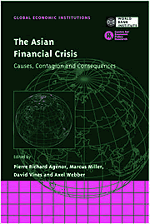Book contents
- Frontmatter
- Contents
- List of figures
- List of tables
- Preface
- List of conference participants
- Acknowledgements
- List of abbreviations and acronyms
- Introduction
- Part One General Accounts
- 1 The role of macroeconomic and financial sector linkages in East Asia's financial crisis
- Discussion
- 2 The Asian crisis: lessons from the collapse of financial systems, exchange rates and macroeconomic policy
- Discussion
- 3 Are capital inflows to developing countries a vote for or against economic policy reforms?
- Discussion
- 4 The Asian crisis: an overview of the empirical evidence and policy debate
- Discussion
- Part Two Theoretical Contributions
- Part Three Contagion
- Part Four Policy Responses
- Index
Discussion
from Part One - General Accounts
Published online by Cambridge University Press: 26 February 2010
- Frontmatter
- Contents
- List of figures
- List of tables
- Preface
- List of conference participants
- Acknowledgements
- List of abbreviations and acronyms
- Introduction
- Part One General Accounts
- 1 The role of macroeconomic and financial sector linkages in East Asia's financial crisis
- Discussion
- 2 The Asian crisis: lessons from the collapse of financial systems, exchange rates and macroeconomic policy
- Discussion
- 3 Are capital inflows to developing countries a vote for or against economic policy reforms?
- Discussion
- 4 The Asian crisis: an overview of the empirical evidence and policy debate
- Discussion
- Part Two Theoretical Contributions
- Part Three Contagion
- Part Four Policy Responses
- Index
Summary
I congratulate the authors of chapter 1 on their taxonomy of the Asian crises. They make a very complete coverage of the nature and sources of vulnerabilities in the East Asian countries that have experienced the most recent financial crisis. In most discussions of international financial crises – the present as well as the historical – a central debate concerns whether the crises are due to domestic or external factors. Conclusions often lean in the direction of a crisis being generated as a consequence of a combination of domestic as well external factors, but opinions differ on their relative importance. In their chapter 1, the authors deny that they are undertaking any discussion of international aspects of the crisis. Instead, the chapter is an attempt to identify the nature and the sources of vulnerabilities in the East Asian economies.
Having narrowed the focus to an analysis of domestic factors leaves the task of identifying which domestic factors were behind the crisis. Historical experience and economic theory tell us that short-term macroeconomic policies, as much as structural microeconomic attributes, institutional setting and inevitably their interaction deserve attention. The chapter starts with the assertion that ‘the build-up of financial vulnerabilities in East Asia was associated with reinforcing dynamics between capital flows, macro policies and weak financial and corporate sector institutions.’ Put this way, I find very little to disagree with the authors' analysis, and find that they present a highly informative and valuable overview.
- Type
- Chapter
- Information
- The Asian Financial CrisisCauses, Contagion and Consequences, pp. 64 - 66Publisher: Cambridge University PressPrint publication year: 1999



